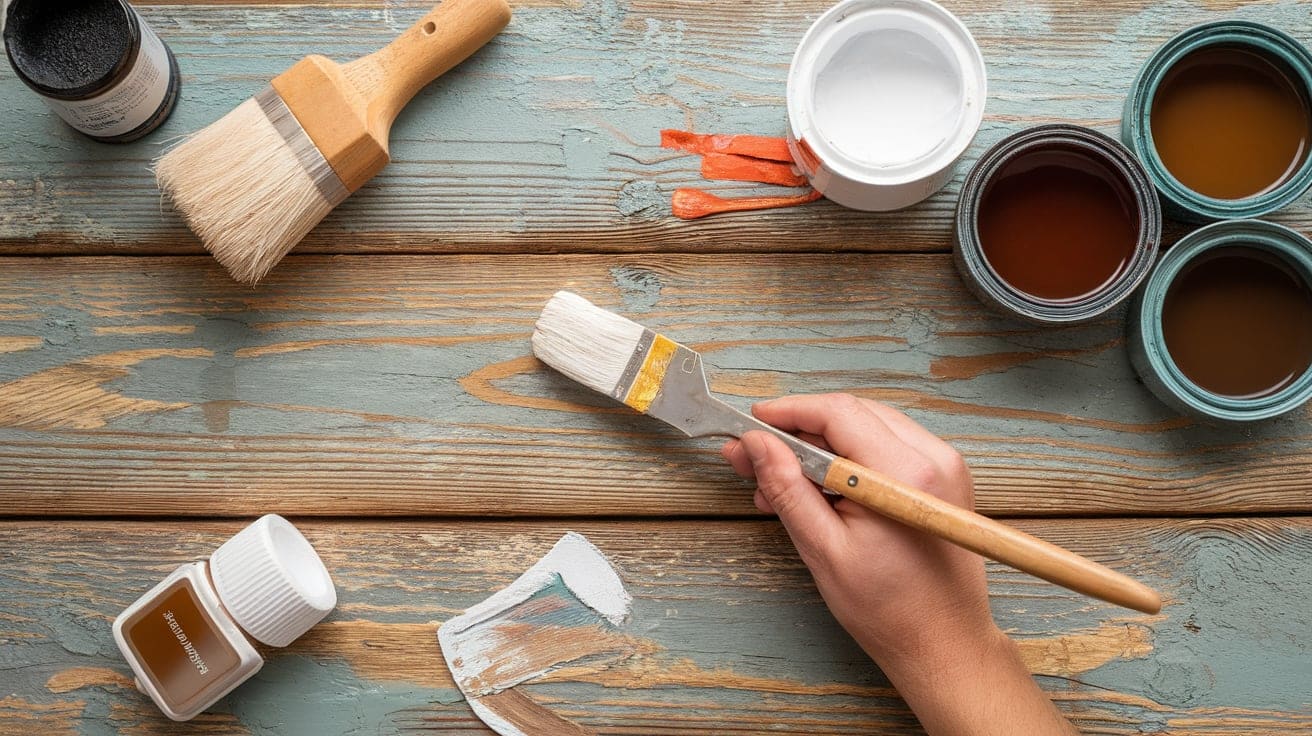Want to know how to create that soft, muted wood finish that makes furniture look timeless? Paint wash techniques offer a simple way to update wood without hiding its natural beauty. This method creates a thin layer of color that allows the wood grain to show through.
With five different methods to try, you can find the perfect look for your project. From oak to cedar to poplar, each wood type takes paint wash differently. The results range from subtle and smooth to rustic and textured.
These methods work on furniture, walls, floors, and even photography backdrops. Are you ready to learn how to transform wood with a paint wash?
Let’s look at five proven methods that give stunning results.
Choosing the Right Wood for Paint Washing
Before starting your paint wash project, understand that different wood types accept finishes in unique ways. Oak has a strong grain pattern that can resist even coloring. Poplar absorbs finishes deeply, making it ideal for smooth, consistent results.
Fur and cedar offer rustic textures that work well with thicker applications. The age, quality, and previous treatments of your wood also affect the final look. Most paint wash techniques work best on raw, unfinished wood.
Suppose you are working with previously finished pieces, sand thoroughly to remove old finishes. When selecting your wood, choose pieces with interesting grain patterns if you want these features to show through your paint wash.
5 Simple Whitewash Styles to Change Any Wood Piece
Learn how to use basic whitewashing methods to update old furniture with minimal tools and time.
Tools and Materials Needed for Paint Wash Wood
| Category | Item |
|---|---|
| Wood Materials | Various wood pieces (oak, poplar, fir, cedar) |
| Surface Prep | Sandpaper (120–150 grit), Sanding sponges, Pre-stain wood conditioner |
| Application Tools | Clean rags or lint-free cloths, Foam brushes, Chalk paint, White wash stain |
| Mixing Supplies | Clean water, mixing containers, Measuring cup |
| Miscellaneous | Putty knife, Grout (pre-mixed, single component), Protective gloves |
| Setup Essentials | Drop cloth, Popsicle sticks (for spacing boards) |
Method 1: Classic White Wash on Oak
Start by sanding your oak piece to 150 grit, making sure all surfaces are smooth. Remove all sawdust with a clean cloth. Apply pre-stain wood conditioner with a foam brush, following package directions. This helps the whitewash penetrate evenly.
Next, use a foam brush to apply a thick coat of whitewash stain. Let it soak into the wood for about 10 minutes. Use a clean, lint-free cloth to wipe off excess stain. How hard you wipe determines the finish—wipe firmly for less color, gently for more.
For an uneven, time-worn look, wipe harder in some areas. Use even pressure for consistency. Allow the piece to dry completely before using or applying a protective finish.
Method 2: Hazy Finish on Poplar
Poplar works wonderfully for a smooth, hazy finish. Sand your poplar boards to 150 grit and clean off all dust. Mix chalk paint with water in a 1:1 ratio to create a diluted mixture. Apply this watered-down paint to the wood using a foam brush.
The diluted paint will soak right into the poplar. Use a clean cloth to even out the application, moving with the grain. This creates a subtle, soft look with minimal grain showing. For a more opaque finish, apply additional coats after the first one dries.
The chalk paint gives a very matte finish, perfect for modern styles. This technique works well on furniture pieces where you want a clean, consistent color.
Method 3: Rustic Look on Rough Fur
For a more country-style finish, use rough, unsanded fur two-by-fours. The natural texture adds character to the final result. Mix chalk paint with water using a 70% paint to 30% water ratio. This thicker mixture creates more coverage than the previous method.
Apply the mix heavily with a brush to at least three sides of each board before assembly. Do not wipe off the excess – let it soak in and dry. When constructing panels, use popsicle sticks to create small gaps between boards to allow for wood movement.
After the paint dries completely, use a 120-grit sanding sponge on the high points of the grain to reveal hints of natural wood color.
Method 4: Grout Finish on Cedar
This unique approach uses tile grout for a truly distinct finish. Create a panel from cedar two-by-sixes, sanded lightly if desired. Moisten the wood surface with clean water using a spray bottle or a damp cloth.
Apply a thick layer of pre-mixed tile grout using a putty knife, spreading it evenly across the surface. Use a wet rag or sponge to even out the coating and remove excess. The grout sticks to the wood fibers, creating a durable, stain-resistant finish.
This technique fills spaces between boards and any knot holes or dents. The result resembles old-world plaster finishes used before modern paints existed. This method works particularly well for feature walls or floor applications where durability matters.
Method 5: Combined Techniques on Fur
For the most complex and layered finish, try combining methods. Start with two-by-twelves sanded to 150 grit. Apply pre-stain wood conditioner following product instructions. Use whitewash stain as in Method 1, allowing it to cure fully.
Once dry, apply a layer of grout over the top, as described in Method 4. This two-step approach fills recesses in warped boards while creating a smooth, even, hazy finish. The multiple layers add depth and interest to the surface.
This technique works beautifully for headboards, loft flooring, or feature walls where you want wide boards with minimal labor. The layered approach offers excellent coverage while still maintaining the wood texture.
Whitewash Like a Pro: Essential Tips for Success
- Test First – Always test your mixture on scrap wood before starting your main project.
- Wood Matters – Pine and other softwoods soak up more wash than hardwoods like oak or maple.
- Grain Direction – Apply and wipe with the grain to get the most natural and smooth-looking finish.
- Lint-Free Rags – Use only clean, lint-free cloths to avoid tiny fibers getting stuck in your finish.
- Consistency – Keep your application method the same across the whole piece for an even look.
- Work Method – Move at a steady pace between applying and wiping before the wash dries too much.
Don’t Let These White Wash Mistakes Happen to You
| Mistake | Consequence | Better Alternative |
|---|---|---|
| Using oil-based over water-based | Causes yellowing and peeling | Use water-based products only |
| Skipping sanding | Makes the finish blotchy | Sand to at least 150 grit |
| Applying in direct sunlight | Dries too fast, leaves streaks | Work in shade or indoors |
| Using dirty rags | Adds dust or fuzz to the finish | Use clean, lint-free cloths |
| Not testing on scrap wood | Gives unpredictable results | Test on similar scrap wood |
| Rushing drying time | Causes smudges and uneven color | Let each coat dry 24+ hours |
| Applying too heavily | Looks painted, not washed | Use thin layers and wipe off excess |
| Sealing too soon | Finish turns cloudy or peels | Wait 48–72 hours before sealing |
Conclusion
Paint wash techniques offer a simple way to bring old-world charm to wood surfaces. By following these five methods, you can create finishes ranging from subtle and soft to textured and rustic.
Each wood type responds differently to these techniques, giving you many options for your projects. The key to success lies in proper preparation, careful application, and patient drying time.
For long-lasting results, remember to maintain your finished pieces with gentle cleaning and occasional refreshing. Avoid common mistakes like rushing the process or using incompatible products.
Whether making furniture, wall panels, or photography backdrops, these paint wash methods create timeless looks that enhance your home.
With practice, you’ll develop your style and preferences for creating beautifully finished wood pieces that showcase both color and natural grain.
Frequently Asked Questions
1. Can I Paint Wash Over Previously Stained Wood?
Yes, but sand the surface fully to remove any sealer or top coat first.
2. How Long Does Paint Wash Last on Outdoor Furniture?
Without added protection, about 1-2 years; with proper sealing, 3-5 years.
3. Can I Get a Darker Wash Effect Instead of White?
Yes, use gray, blue, or tan washes for more color while still showing the wood grain.
4. Will Paint Wash Work on Laminate or Veneer Surfaces?
No, paint wash works best on real wood that can absorb the wash mixture.













